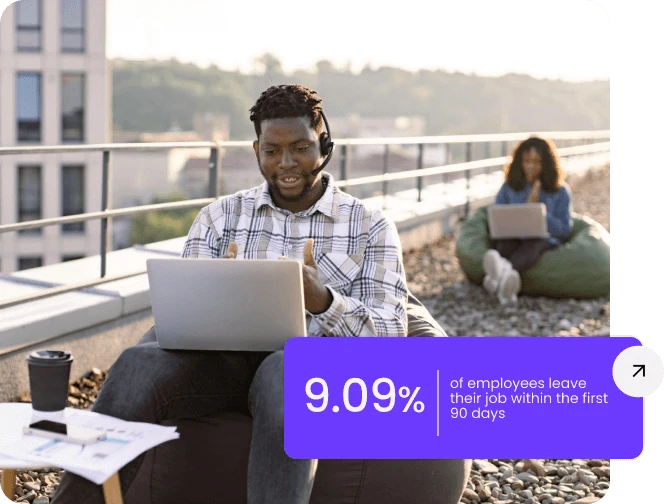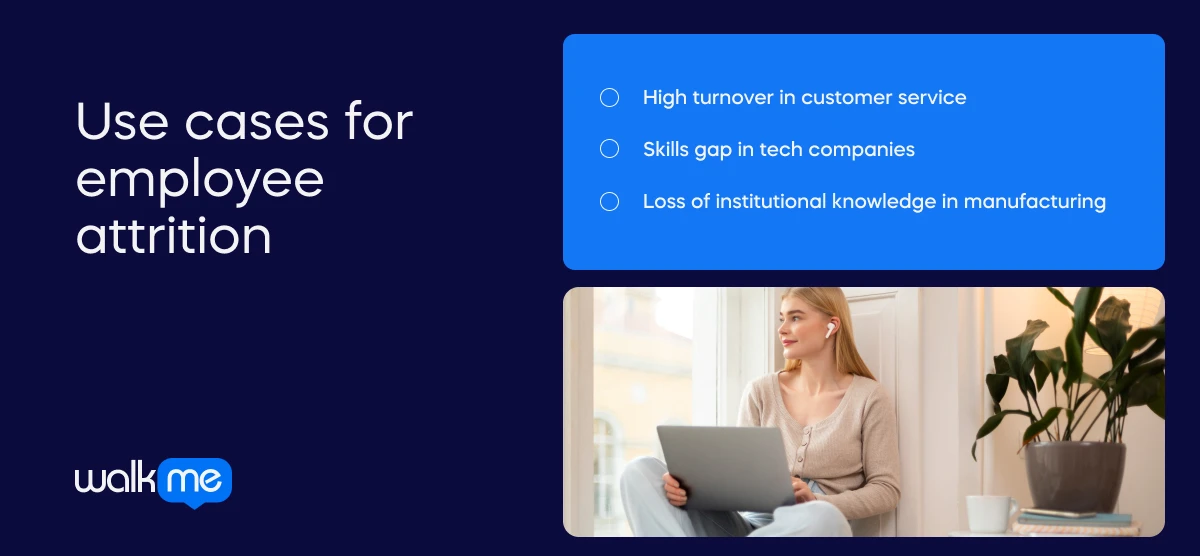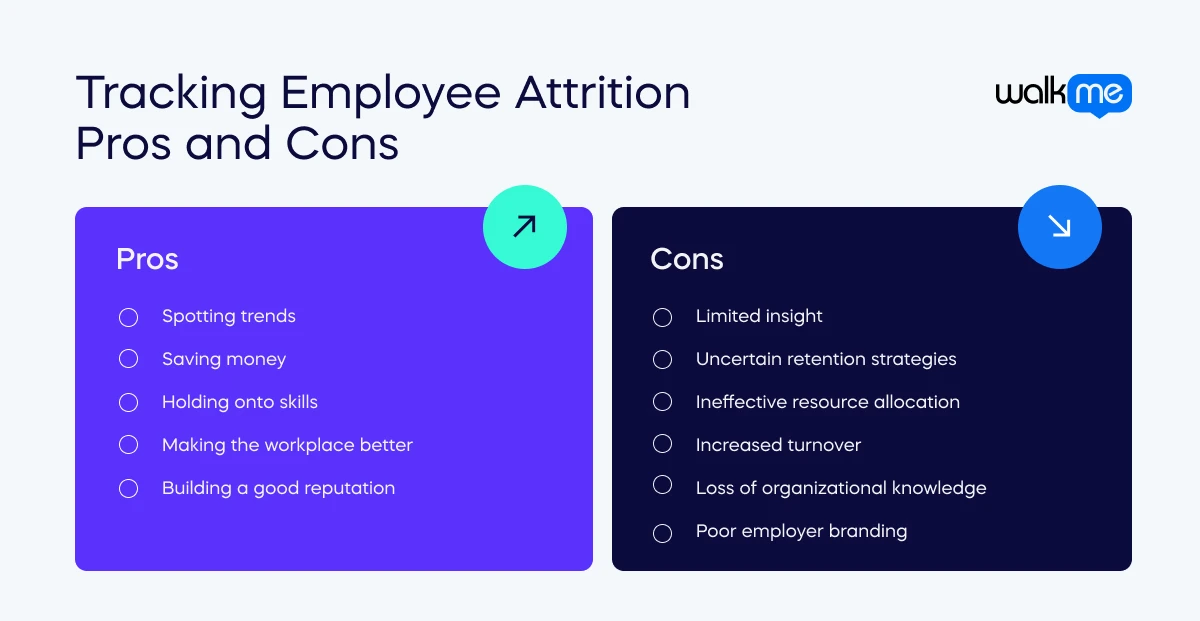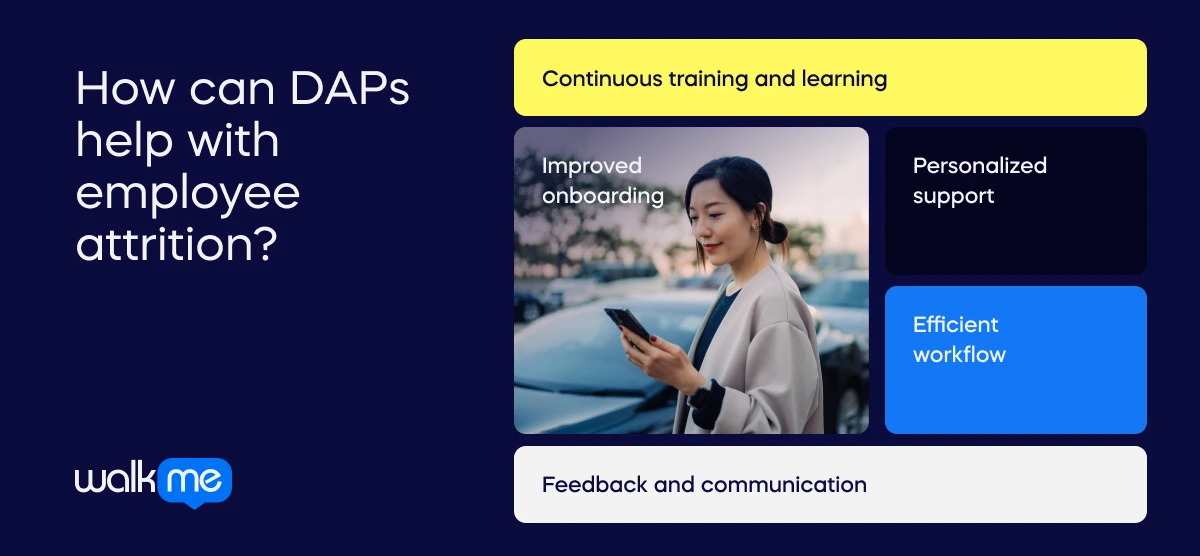What is employee attrition?
Employee attrition refers to the gradual reduction in the workforce due to employees leaving the organization over time.

It happens for one of the following reasons:
- Voluntary attrition: An employee chooses to leave the company.
- Involuntary attrition: The company decides to part ways with the employee.
- Retirement: An employee leaves the company once they reach retirement age.
- Demographic attrition: When some types of people leave a company more than others.*
Unlike turnover, attrition often implies that the positions are not immediately filled, leading to a decrease in the overall number of employees. Every organization deals with attrition. However, managing it effectively is crucial. For example, statistics on voluntary attrition reveal that the average 90-day turnover is 9.09%. In other words, almost 1 in 10 employees leave a job within 3 months of starting it. If attrition becomes too high, it costs the company more to find and train new people. The company loses knowledge and morale can drop. So, businesses try to keep attrition low. They improve workplace culture, offer good benefits, help employees grow, and conduct exit interviews to gather feedback from departing employees. *Demographic attrition can be because of age, gender, or ethnicity. For instance, if older workers are leaving more than younger ones, that’s demographic attrition. Reasons might include retirement patterns, job growth chances, or how the workplace feels. By understanding this, companies can keep a mix of workers and be fair in how they hire and treat people.
Employee attrition vs. employee turnover
It can be easy to get employee attrition confused with employee turnover, and vice versa. In essence:
- Employee attrition is about why employees leave
- Employee turnover is about how often employees leave
Here’s a more detailed breakdown:
| Employee attrition | Employee turnover | |
| Definition | When workers naturally leave a job because of things like retirement or finding a new job. | How often workers leave their jobs, either on their own or because they’re asked to. |
| Focus | Understanding why workers leave and trying to keep them around. | Keeping track of how many workers leave and why, and trying to make sure it doesn’t happen too much. |
| Techniques | Talking to workers who leave, seeing if there are patterns in why they go, and trying to make the job better so they stay. | Counting how many workers leave and why, trying to hire and keep good workers, and making the workplace a good place to be. |
| Goals | Trying to stop workers from leaving too often, so the company doesn’t lose important people. | Making sure not too many workers leave, so the company can keep running smoothly. |
| Examples of use | Giving workers more chances to learn new things, making the job more flexible, and making sure they’re paid well. | Checking why workers leave, making sure they feel appreciated, and giving them opportunities to grow in the company. |
Use cases for employee attrition

Here are some examples of how employee attrition can take place in organizations:
High turnover in customer service
In a call center, employees keep resigning. As a result, recruitment is an ongoing activity. Training also becomes constant, which means productivity levels go down. Furthermore, customers experience longer waiting times. They also experience lower service quality as the representatives are less experienced.
Skills gap in tech companies
In a technology company, employees leave for better opportunities elsewhere. A skills gap is left in the organization, and this has multiple consequences. Project progress is slower and product launches are delayed. Plus, the company has increased costs as they invest in retraining or hiring talent.
Loss of institutional knowledge in manufacturing
In a manufacturing plant, experienced workers retire or quit in large numbers. This means valuable industry-related knowledge is lost. As a result, errors are made in production and there are more safety hazards. What’s more, new workers are less experienced. They struggle to learn new processes due to the loss of experienced workers.

Advantages of tracking employee attrition
When companies track employee attrition, they can enjoy the following benefits:
Spotting trends
Watching who leaves helps find patterns, so problems can be fixed.
Saving money
Lowering how many people leave saves money on hiring and training new workers, and keeps the business running smoothly.
Holding onto skills
Seeing who’s leaving helps keep important skills in the company by finding ways to make people want to stay.
Making the workplace better
Figuring out why people leave helps make the workplace happier and nicer for everyone.
Building a good reputation
When fewer people leave, the company looks good and attracts more good workers.
Challenges of not tracking employee attrition
If workplaces do not track employee attrition, they may experience the following challenges:
Limited insight
Without keeping track, it’s hard to know what’s happening with the workforce, making it tough to figure out how to improve and keep people around.
Uncertain retention strategies
If the reasons why people leave are unknown, it’s tricky to know what to do to make them stay.
Ineffective resource allocation
Not knowing why people leave might mean spending resources in the wrong places, which won’t help keep them.
Increased turnover
Ignoring why people leave can lead to more people leaving, creating a constant cycle of hiring and training new workers.
Loss of organizational knowledge
Not paying attention to who leaves means losing valuable skills and knowledge that could help the company.
Poor employer branding
High turnover rates can make the company look bad as an employer, making it harder to find new workers.
How can DAPs help with employee attrition?

Employees leaving a workplace can be linked to key issues. These include poor onboarding experiences or lack of support with digital tools. The good news is that digital adoption platforms like WalkMe can help. Using such platforms can improve employee engagement, training, and overall satisfaction. Here’s how: Improved onboarding DAPs can provide guided onboarding processes. These ensure new employees receive clear instructions and support as they learn their roles. This helps them feel confident and engaged from the start. It reduces the chance of them leaving due to feeling overwhelmed or unsupported.
| How can WalkMe help? In-app guidance provides prompts and tips while users are within the software. They learn how to use digital tools more quickly. Importantly, they receive clear instructions and support right when and where they need it. |
Continuous training and learning DAPs offer ongoing training and support for employees. It helps them to use various digital tools and systems within the organization. This continuous learning environment keeps employees engaged and invested in their development. They will become less likely to leave due to feeling unchallenged. It’s vital for companies to consider the upskilling opportunities available. That’s because almost half of employees would move to another job if the organization offered the chance to learn new skills.
| How can WalkMe help? The platform helps employees to learn continuously. For example, guided workflows can feature quizzes, polls and branching logic. These elements help to create a bespoke learning experience. As users continue navigating the platform, in-app prompts encourage them to consistently acquire new skills. This helps with adapting to organizational and industry changes. |
Personalized support DAPs can offer personalized guidance and support. It’s based on individual employee needs and skill levels. By tailoring assistance to each employee’s requirements, DAPs can help them overcome challenges more effectively. As a result, employees feel more satisfied with their work.
| How can WalkMe help? The in-app guidance feature provides users with personalized checklists. This helps them to progress and become proficient in less time. |
Efficient workflow DAPs streamline workflows by providing step-by-step guidance. They can also automate repetitive tasks. This improves productivity and reduces frustration. Employees feel more efficient and valued in the workplace, so they are less likely to leave.
| How can WalkMe help? With AutoSteps, users can automate a repetitive process and free up their time for other tasks. This ensures that productivity levels remain high. |
Feedback and communication DAPs often let users provide feedback. In this case, employees can discuss their experiences and suggest improvements. When workers feel they can communicate and address concerns quickly, they will be encouraged to stay in the role.
| How can WalkMe help? WalkMe provides a Surveys feature so that employees can provide feedback. Management can then track and action the comments to improve the experience. |
Success stories: Reducing employee attrition with WalkMe
We mentioned that employee attrition can be linked to issues such as poor onboarding experiences or inadequate support with digital tools. WalkMe has helped numerous companies to improve employee engagement, training and satisfaction by addressing these pain points. Here is how they helped Sprinklr:
Sprinklr x WalkMe
Sprinklr needed a plan to accelerate onboarding for their employees. WalkMe’s DAP was overlaid across ten applications. Once rolled out, the engagement rate was 85%. Sprinklr’s employees benefited from having contextual guidance. Internal support requests were reduced, and employee productivity improved.
Tackling employee attrition with DAPs
Employee attrition is undoubtedly a big issue for companies. It often happens due to issues such as bad training or workers not getting help with digital tools. The good news is that DAPs like WalkMe can make a big difference. They can help with training, support with digital tools, and make employees happier overall. Looking ahead, these digital tools could be a game-changer for keeping employees happy and stopping them from leaving. So, for companies, it’s important to embrace these tools to make sure employees stick around and are satisfied with their jobs.